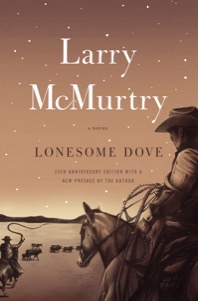
I had heard more than a few friends talk glowingly about Lonesome Dove, a book that ends up at or near the top of any list you’ll ever find of “best western novels”. When I stumbled across Lonesome Dove on a list of books Roxane Gay said she would have students read, were she to teach a course on modern fiction with a focus on diversity of voice, I decided to pick it up.
I’m so glad I did. Lonesome Dove sucks you in, but not in the way many modern novels do. The book follows a cattle run from Texas to Montana, set shortly after the Civil War. It’s an epic setting, but the book is much more character-driven than it is plot-driven.
The characters are so remarkably vivid, and not just the primary ones. There’s a rich cast of characters who get detailed backstories, and we spend time with most of them as a point-of-view character for at least a chapter or two. The result is you end up feeling invested, whether good or bad, in the fates of them all.
McMurtry decided to ignore the “romanticized” version of the west that so many Western novels at the time appeared to readily embrace. He wanted to write the “anti-western” (as he put it) and paint his characters and their behavior as it really was. Whether he succeeded or not depends on who you talk to and how deeply you consider the characters.
There’s still a bit of the romantic western in play—Gus, in particular, has a bit of a mythic aura. But the characters are flawed, often deeply. They’re emotionally stunted. They say and do things that make you cringe. As McMurtry put it later to one reporter “Would you want to live with these men?”
A lot of this is explored through the role of Newt, the youngest in the company. McMurtry has stated that Newt could be thought of as “the lonesome dove” and he acts as a bit of a stand-in for us, the readers. At the start, young Newt looks up to so many of the men in the company, idolizing them–viewing them through that mythic lens. The cattle drive itself is also viewed with excitement and general romance. But as the book goes on and tragedy after tragedy strikes, he becomes increasingly disenchanted with it all. By the end, he is left bitter and angry. The drive was dangerous with real-world consequences he hadn’t considered. Many of his heroes are dead, and those that aren’t have disappointed him as their veneer has worn off and he’s seen how very flawed they are.
That’s the strength of this novel: the characters. They surprise you, they upset you, they make you cry. You get attached to them and every failure along the journey—every loss—is felt all the more deeply. Even after 850 or so pages, I still found myself wishing I could have more time with them.
Their stories don’t end the way you think they will. Some characters are abruptly killed off in ways that seems almost insulting to the level of importance they seemed to carry to the novel. Many of the missions that characters embark on end up failing unspectacularly. You keep thinking you know where this is going, but it never really does. The results for many characters and plotlines aren’t what you expect, but it’s much closer to what real life would be: real life doesn’t always get the Hollywood ending.
There’s not a lot of action. It’s very safe to say that the book is much more character-driven than it is plot-driven. When you do stumble on an action scene, it makes them stand-out even more. Scenes like Gus being pinned down behind his horse, outnumbered five to one or the bear facing off against the bull keep you breathless and are unforgettable.
Since seeing it on Gay’s list, I’ve been thinking about why it made her list. It’s a historical novel set shortly after the civil war, and McMurtry makes no attempt to pretend conditions were better than they were for anyone involved. Women are mostly treated poorly as are black people. The men in the cattle herding company constantly worry about Native Americans and talk disparagingly of them as well as of Mexicans.
But instead of ignoring the issues, McMurtry takes numerous opportunities to explore them through various different lenses. He builds characters like Elmira, Janey, Clara (a particularly strong character) and Deets that buck the stereotypes the other characters have. The effect is often comedic as other characters are at times very visibily uncomfortable when confronted with these people who don’t match their worldview at all. The book explores the consequences of the way Native Americans were viewed and treated, often through the voice of Gus. McMurtry doesn’t provide any clear-cut statements, but he also refuses to let the reader ignore the ugliness of it all.
I could go on and on about this book and all the different themes, the different characters and the different thoughts and emotions it provoked, but I’m already beginning to ramble. Suffice it to say I thoroughly enjoyed this book and will be returning to it again in the future.